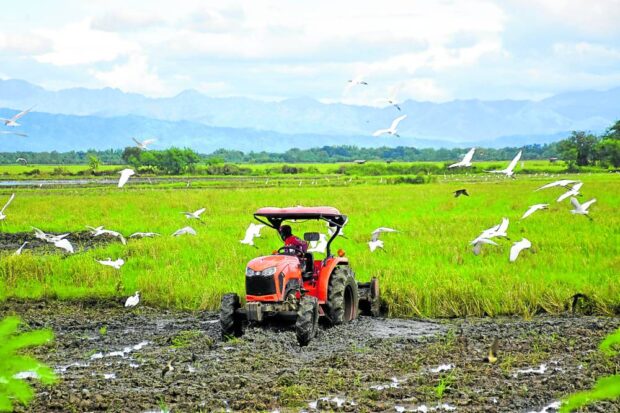Agri land conversion, commercial use lead PH to import rice

FARMING MADE EASY In this photo taken in January, a farmer in Urdaneta City, Pangasinan, uses a tractor to prepare his land for planting rice. Farmers in the province now use machines and
modern equipment provided by the government to increase the speed and efficiency of farm operations. —WILLIE LOMIBAO
MANILA, Philippines — Is the Philippines still an agricultural country? A people’s lawyer expressed worry that the country risks losing the moniker with its agricultural lands facing “massive conversions.”
According to Sentro Para sa Tunay na Repormang Agraryo lawyer Atty. Jobert Pahilga, the non-stop conversion of agricultural land for residential and commercial purposes is one of the reasons why the Philippines has been relying on importation to boost its rice supply despite being dubbed an “agricultural” nation.
READ: DA mulls setting farm-gate prices for non-palay produce
“Batay sa data namin, mahigit sa 700,000 hectares ng taniman ng palay ang na-convert na into other uses. Hindi pa kasama diyan iyong mga iligal na na-coconvert,” he told Inquirer.net.
(Based on our data, more than 700,000 hectares of rice paddies have been converted for other uses. That’s excluding illegal conversions.)
Because of this, Pahilga said, less and less of the staple grain is being harvested locally throughout the years.
Article continues after this advertisementThe people’s lawyer explained that farmers are forced to sell their rice paddies to developers because farming rice has been unprofitable.
Article continues after this advertisement“Ang ating mga magsasaka, napipilitan na magbenta ng lupa o pinipili na lamang hindi magtanim ng palay. Maliit ang kita sa palay. Lumalabas na lugi ang magsasaka sa produksyon ng palay,” he noted.
(Our farmers are forced to sell their land or choose not to plant rice. The profit from rice is minimal. It turns out that farmers incur losses in rice production.)
Pahilga detailed that the cost of production for one hectare of a rice plantation in the Philippines is P80,000 to P100,000.
Despite this capital, farmers would be forced to sell their produce at low farm gate prices, which is not enough to turn a profit.
“This harvest season, they [farmers] reached a price of P11 per kilogram [kg]. If that’s the (farmgate) price of rice, there is no doubt that farmers would not earn from planting it,” the lawyer said in Filipino.
But while the farmgate prices of the staple are low, its retail price in local markets remains high.
According to the Department of Agriculture’s (DA) price monitoring of markets in Metro Manila, as of January 22, local well-milled rice is sold at P49 to P55 per kg while its imported counterpart is sold at P54 to P56.
With the decreasing number of rice paddies in the country, Pahilga said there is no doubt that the country would rely on importation to meet the demand for the staple grain.
On Sunday, the US Department of Agriculture predicted that the Philippines would remain the number one rice importer in the world.
READ: Philippines stays as world’s top rice importer
The forecast comes as the country prepares for the looming effects of the El Niño climate phenomenon.
Solutions
The lawyer pointed out that the solution for boosting the country’s local production of rice is simple – improve its land use policies.
“We must not let our (agricultural) land be converted because what happens is that we rely on importation,” Pahilga urged, saying that the government must not allow the unabated conversion of rice paddies for residential and commercial uses.
He also took a jab at the Rice Tariffication Law, which he said must be reviewed to prevent the “flooding” of imported rice in the country.
Meanwhile, the DA said it wanted to invest P1.3 billion to improve the country’s local rice production and prevent agricultural waste.
READ: Gov’t targets P1.3-trillion investment to boost rice output
The department explained that to boost the country’s rice output, it is necessary to build integrated rice mills, warehouse complexes, and post-harvest facilities.
The DA, in a previous statement, likewise expressed intent to set a suggested retail price on rice but U-turned on this statement, saying that it is counterproductive.